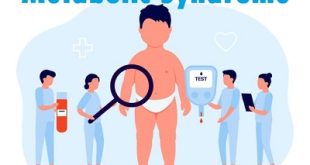Definition
Multiple sclerosis is a disease that involves an immune-mediated process that results in an abnormal response in the body’s immune system that damages central nervous system (CNS) tissues in which the immune system attacks myelin, the substances that surrounds and insulate nerves fibers causing demyelination that leads to nerve damage or blocks the signals. The symptoms you feel depend on which nerves are affected.
History
The first description of what was probably MS dates back to August 4, 1421, when Jan Van Bieren, Count of Holland, described the “strange disease of the virgin Lidwina,” who in 1395, at the age of 15, developed severe facial pain and leg weakness after falling on the ice while skating. Within a few years her problems had increased: her legs were so weak that she could not walk, she had leg numbness and she was intermittently blind in one eye. She died in 1433 at the age of 53. 4 The Facts You Need, Fifth Edition The first descriptions of the physical changes that MS produces in the brain and spinal cord came almost simultaneously, in 1835, from Jean Cruveilhier, professor of pathologic anatomy in the Sorbonne’s Faculty of Medicine in Paris, and Robert Carswell, a Scotsman who worked at the Hôpital de la Pitié in Paris for 3 years. However, the first scientific description of the signs and symptoms of MS came from Jean-Martin Charcot (1825–1893). Charcot outlined a condition called la sclérose en plaques in effect, multiple sclerosis which he had first become familiar with while watching its gradual development in a maid employed in his house. From1862 to 1870, Charcot worked at La Salpêtrière, a Paris asylum for beggars, the aged, the infirm and the insane. There, he examined thousands of patients. His findings led him to correlate the signs and symptoms of MS with the disease-related anatomical changes seen at autopsy
Epidemiology
An estimated 2,500,000 people in the world have multiple sclerosis. Research suggests the proportion of women with MS is increasing and that roughly between two and three women have MS for every man with the condition.
The distribution of MS around the world is uneven. Generally, the prevalence increases as you travel further north or south from the equator. Those parts of Asia, Africa and America that lie on the equator have extremely low levels of MS, whilst Canada and Scotland have particularly high rates.
Types of multiple sclerosis
Relapsing-remitting MS (RRMS)
RRMS involves clear relapses of disease activity followed by remissions. Symptoms are mild or absent during remission, and there’s no disease progression during the remission period. RRMS is the most common form of MS at onset.
Clinically isolated syndrome (CIS)
- CIS involves one episode of symptoms that are due to demyelination in the central nervous system. This episode must last for at least 24 hours.
- The two types of episodes are monofocal and multifocal. A monofocal episode means one lesion causes one symptom. A multifocal episode means you have more than one lesion and more than one symptom.
- Although these episodes are characteristic of MS, they aren’t enough to prompt a diagnosis. If lesions similar to those that occur with MS are present, you’re more likely to receive a diagnosis of RRMS. If these lesions aren’t present, you’re less likely to develop MS.
Primary-progressive MS (PPMS)
- Neurological function becomes progressively worse from the onset of your symptoms if you have PPMS. However, short periods of stability can still occur.
- Progressive-relapsing MS was a term people previously used for progressive MS with clear relapses. People now call it PPMS. The words “active” and “not active” are used to describe disease activity.
Secondary-progressive MS (SPMS)
SPMS occurs when RRMS transitions into the progressive form. You may still have noticeable relapses, in addition to gradual worsening of function or disability.
Risk factors of multiple sclerosis
These factors may increase your risk of developing multiple sclerosis:
Age: MS can occur at any age, but most commonly affects people between the ages of 15 and 60.
Sex: Women are about twice as likely as men are to develop MS.
Family history: If one of your parents or siblings has had MS, you are at higher risk of developing the disease.
Certain infections: A variety of viruses have been linked to MS, including Epstein-Barr, the virus that causes infectious mononucleosis.
Race: White people, particularly those of Northern European descent, are at highest risk of developing MS. People of Asian, African or Native American descent have the lowest risk.
Climate: MS is far more common in countries with temperate climates, including Canada, the northern United States, New Zealand, southeastern Australia and Europe.
Certain autoimmune diseases: You have a slightly higher risk of developing MS if you have thyroid disease, type 1 diabetes or inflammatory bowel disease.
Smoking: Smokers who experience an initial event of symptoms that may signal MS are more likely than nonsmokers to develop a second event that confirms relapsing-remitting MS.
Causes of multiple sclerosis
- While multiple sclerosis is considered an autoimmune disorder, the exact cause hasn’t yet been found.
- There are many theories regarding the reason that people develop MS. These theories range from vitamin D deficiency to a viral infection.
- Even consuming too much salt is being looked at as possible causes. However, none of these theories have been proven, and the cause of MS remains unknown. It’s not contagious, and can’t be passed from person to person.
Symptoms of multiple sclerosis
MS causes a wide range of symptoms, sensations, and/or signs. For many patients, these symptoms come and go. Most people experience their first symptoms of MS between the ages of 20 and 40. Initial symptoms are often eye-related, such as pain when the eyes are moved, dimmed vision, or distortion of colors. Before a person is diagnosed, these signs and symptoms can seem mysterious or worrisome.
Here are some other potential signs and symptoms of MS:
- Tiredness or fatigue
- Numbness, prickling, or “pins and needles” sensations
- Muscle stiffness
- Problems thinking clearly, or being able to concentrate and remember things
- Bladder problems
- Problems with walking
- Depressed mood
Diagnosis and test
Diagnosing multiple sclerosis (MS) isn’t always easy and in some cases may take time.
Your medical history and neurological exam can identify possible nervous system problems and are often enough to strongly suggest a diagnosis of MS. Tests may help confirm or rule out the diagnosis when your history and exam do not provide clear evidence of the disease. MRI and neurological exam may help doctors predict which people will develop MS after a first attack of symptoms.
Tests to diagnose MS
Magnetic resonance imaging (MRI) of the brain and spinal cord: This test is done to confirm a diagnosis of MS camera.
Lumbar puncture (sometimes called a spinal tap): This test may be done to evaluate cerebrospinal fluid. Most people with MS have abnormal results on this test.
Lumbar puncture
Evoked potential testing: This test can often reveal abnormalities in the brain and spinal cord and in the optic nerves of the eyes that other tests may not detect.
Confirming the diagnosis
MS is diagnosed when it is clear from neurological tests and a neurological exam that lesions (damaged areas) are present in more than one area of the central nervous system (usually the brain, spinal cord, or the nerves to the eyes). Tests will also clearly show that damage has occurred at more than one point in time.
Some people have had only one episode of a neurological symptom such as optic neuritis, but MRI tests suggest they may have MS. This is known as a clinically isolated syndrome. Many of these people go on to develop MS over time.
Treatment of multiple sclerosis
There is no cure for MS, so treatment focuses on suppressing the autoimmune response and managing symptoms.
Medications
Several disease-modifying drugs are approved for the relapsing forms of MS.
Corticosteroids: Are the most commonly prescribed drugs for MS. They reduce inflammation and suppress the immune system. They mostly treat an acute flare-up of symptoms in certain types of MS.
Interferon Beta 1a or 1b: These may slow down the progression of symptoms, but they must be used with care, as they can cause liver damage.
Copaxone (Glatiramer): This aims to stop the immune system from attacking myelin. It is injected once a day. Flushing and shortness of breath may occur after receiving the injection.
Tysabri (Natalizumab): This is used for patients who either cannot tolerate other treatments or have not benefitted from them. It increases the risk of developing multifocal leukoencephalopathy, a fatal brain infection.
Mitoxantrone (Novantrone): This immunosuppressant is normally used only in the later stages. It can damage the heart, but if symptoms are worsening rapidly, it can help slow down the progression of disability.
Cannabis extract: Studies have suggested that this may help relieve pain, muscles stiffness, and insomnia.
Aubagio (teriflunomide): This is a once-daily tablet for adults with relapsing forms of MS.
Rehabilitation
Rehabilitation aims to help patients improve or maintain their ability to perform effectively at home and at work.
Programs generally include:
Physical therapy: This aims to provide people with the skills to maintain and restore maximum movement and functional ability.
Occupational therapy: The therapeutic use of work, self-care, and play activities to increase development and prevent disability.
Speech and swallowing therapy: A speech and language therapist will carry out special training.
Cognitive rehabilitation: This helps people manage specific problems in thinking and perception.
Vocational rehabilitation: This helps people with disabilities make career plans, learn job skills, get and keep a job.
Plasma exchange
Plasmapheresis involves withdrawing blood from the patient, removing the plasma, and replacing it with new plasma. The blood is then transfused back into the patient.
This process removes the antibodies in the blood that are attacking parts of the patient’s body, but whether it can help patients with MS is unclear. Studies have produced mixed results.
Vitamin D and Omega-3 supplements
Researchers have found a link between vitamin D deficiency and MS, but they are still investigating whether vitamin D supplements might help in treatment. Patients should not use supplements without first consulting their doctor.
It has been suggested that omega-3 fatty acid supplements may help patients with MS, but scientists in Norway concluded that they do not.
Hyperbaric oxygen therapy
It has been suggested that hyperbaric oxygen therapy (HBOT) may help people with MS, but this is unproven.
Prevention of multiple sclerosis
In general, there is no way to prevent multiple sclerosis (MS) or its attacks. For people with relapsing-remitting MS and secondary progressive MS, treatment with medicine may reduce the frequency of relapses and delay disability.
 Diseases Treatments Dictionary This is complete solution to read all diseases treatments Which covers Prevention, Causes, Symptoms, Medical Terms, Drugs, Prescription, Natural Remedies with cures and Treatments. Most of the common diseases were listed in names, split with categories.
Diseases Treatments Dictionary This is complete solution to read all diseases treatments Which covers Prevention, Causes, Symptoms, Medical Terms, Drugs, Prescription, Natural Remedies with cures and Treatments. Most of the common diseases were listed in names, split with categories.








my head
nice message for m.s more
benefit for m.s people.thanks lot
I’m a keralite but yes I’m suffering RRMS I’m suffering it from the past nine years. Every year one or the other relapse occurs with me. This time I can’t neither walk properly nor control my urine. So please help me with any cure.
Consult a doctor to get cure from this problem.
Ive had many MS symptoms, including brain lesions, banding in my spinal fluid, legs going completly knub for a year, and still contunue to so, with pain. Also constantly falling almost daily. My legs do not want to work.
My problem is this, I went to see a MS Dr here in Atlanta, GA. He went over my symptoms and MRI’s and concluded my back was not damaged enough for me to have MS. So I totally dont understand this. Ive got so many of the symptoms, most not mentioned here.
Is this accurate?
Symptoms may vary based on the physical condition of a person.
Was diagnosed in 2000. Using fingolimod ie. Gilenya (generic alternative is Tuvigin) and responding well using this. Most people don’t know that I’m living with MS.